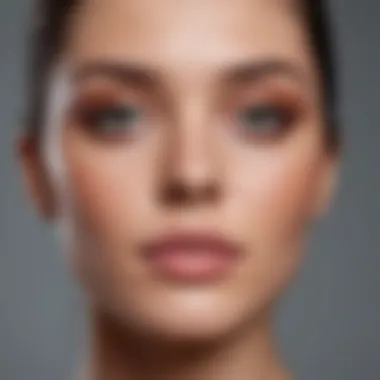Makeup That Benefits Skin: A Complete Guide


Intro
Makeup serves as a fascinating confluence of beauty and self-expression, yet it often resides within a gray area of skincare and health. For many, the goal is not merely to present skin in its most flattering light, but to care for it simultaneously. This article will illuminate products and techniques that satisfy both criteria. We will examine ingredients that nurture, recommended products for varied skin types, and application techniques that enhance overall skin health. Understanding these aspects is vital for a coherent self-care and beauty regime.
Fashion Trends & Style Guides
Latest Fashion Trends
In the realms of makeup and fashion, trends are ever-evolving—what’s in today may be out tomorrow. Current makeup trends emphasize a more natural look. People are now opting for lightweight formulas that allow their skin to breathe. Brands like Fenty Beauty and Glossier have popularized skin tints over heavy foundations, catering to audiences seeking coverage without sacrificing comfort.
Seasonal Style Guides
With every season comes an opportunity to refresh your makeup repertoire. During spring, lighter shades and dewy finishes dominate. The focus is on achieving a fresh and vibrant appearance that reflects the blooming environment. Conversely, during fall, rich and deeper hues complement the transition of nature. Opting for earthy colors here can mirror the seasonal palette and invite warmth without overwhelming the complexion.
"Makeup can be used as a tool for empowerment when approached meaningfully and blending it with effective skincare practice."
Anonymous
Celebrity Fashion Lookbooks
Celebrities often set standards for beauty and makeup trends. Icons like Zendaya and Lupita Nyong'o not only showcase diverse styles but also champion products that nurture the skin. Their choices serve as inspiration, encouraging consumers to explore makeup that enhances rather than harms
Accessories & Styling Tips
When integrating makeup with fashion, accessories should not be overlooked. A well-placed lipstick or highlighting the eyes can elevate simple outfits. Natural makeup intertwined with statement accessories creates a balance that draws attention without overwhelming.
Beauty & Wellness
Beauty Product Reviews
In the current beauty landscape, it’s essential to explore product reviews critically. Many products claim to be 'skin-friendly,' but real feedback dissects efficacy and allergic reactions. Category leaders like Clinique and bareMinerals often receive praise for their quality and performance. Users should always take time to select products by examining ingredient lists for hydration and nourishment.
Skincare Routine Tips
To maximize the benefits derived from makeup, quality skin care is paramount. A balanced routine entails cleansing, moisturizing, and regular exfoliation. Always assess product compositions. Popular ingredients such as hyaluronic acid or retinol can fortify the skin properly before applying makeup.
Hair Care Secrets
While the primary focus tends to be on facial makeup, hair care also plays a crucial role in overall aesthetic appeal. Protect hair with heat-resistive sprays before styling. Use sulfate-free shampoos which not only maintain health but can also combine well with skin-friendly cosmetic products.
Makeup Tutorials
Understanding product application profoundly affects visual results. Youtube is rich with tutorials from seasoned artists who provide step-by-step guides tailored for all looks. These visual aids take the mystery out and simplify the technique, allowing individuals to find their personal style more easily.
The End
Navigating the world of makeup that is beneficial for skin requires discernment and knowledge. By focusing on formulations known for skin-nourishing properties, audiences are empowered to make choices that resonate with their beauty philosophy. Makeup becomes not a means to cover up imperfections, but a potent ally in skin wellness and radiance.
Prelims to Skin-Friendly Makeup
Makeup plays a significant role in how we present ourselves to the world. Many people see it as a tool for self-expression and creativity. However, there is a dual nature to beauty products: they can enhance appearance, but they can also impact skin health. This paradox is the focus of the section titled 'Introduction to Skin-Friendly Makeup.' It is critical to understand how our choices in makeup formulations can either benefit our skin or contribute to issues such as irritation, breakouts, or premature aging. This part of the article sets the stage for a deeper exploration of skin-friendly options as a growing segment in the vast makeup industry.
Understanding Makeup and Skin Health
Traditionally, makeup has been seen mainly for cosmetic enhancement. However, there is increasing awareness of ingredient impacts on skin health. Many foundations, concealers, and powders can contain potentially harmful components. When choosing makeup, considering ingredients is increasingly important for maintaining skin's integrity. Skin sensitivities and allergies highlight a growing need for mindful selection.
One major aspect is understanding how makeup interacts with skin types. Oily, dry, and sensitive skins require targeted formulations. Modern consumers demand products that not only improve skin appearance temporarily but promote better skin quality over time.
To sum up, integrative thinkers in beauty consider makeup as an extension of skincare. Following ingredients, benefits, and proper application techniques connects makeup to overall skin health, the core of balm solutions in this topic.
The Rise of Clean Beauty
The clean beauty movement has reshaped the conversation surrounding makeup. Many brands prioritize transparency and ethical sourcing. These products often meet specific criteria, from formulation without harmful chemicals to environmentally responsible packaging. Such an informed approach taps into a growing demand for incorporatingskin nourishment with aesthetic needs.
Popularity in clean beauty grows particularly among those desiring to limit synthetics. Women of all ages increasingly scout for healthier options and supplies. As consumers gather more information, advertising boasts of clean labels, hypoallergenic claims, and vegan certifications.


“Clean beauty is not just a trend; it's a mindset shift in how we view our beauty products and their effects on our bodies.”
This rise indicates a pivotal theme as we advance. Detoxing makeup influences personal well-being, alongside borader societal responsibilities. Understanding clean beauty highlights lasting changes to health-conscious purchases. These趟 developments outline a standard graduates thrive to engaging thoughtful ways enlightening their makeup rituals.
Key Ingredients to Look For
Identifying key ingredients in makeup products is essential to ensure they benefit complexion and overall skin health. Ingredients can enhance hydration, soothe irritation, or boost nourishment. Making informed choices here directly impacts how your skin reacts to makeup, allowing it to look radiant while being well-care for. Focus on key components such as hydrating agents, soothing elements, and beneficial natural oils.
Hydrating Components
Hyaluronic Acid
Hyaluronic acid serves to bind water to skin cells. Its main feature is its unique ability to retain moisture—holding up to 1000 times its weight in water. This characteristic makes it a favorable choice for makeup products, allowing them to maintain hydration throughout the day. This ingredient is especially effective in various skin types, promoting a dewy appearance without excess oil.
However, it's important to apply it on damp skin to maximize its benefits. If applied to dry skin without moisture, it can have opposite effect by drawing moisture out. So using hyaluronic acid correctly is key!
Glycerin
Glycerin is a glycerol that naturally attracts moisture from the environment or deeper within the skin. It acts as a humectant, providing hydration by pulling water into the skin. This elegant aspect is why glycerin is prominent in many skin-friendly makeup products. It helps maintain elasticity and gives a soft touch.
The downside could include a sticky feeling if too much is applied. So vanilla it, moderation is vital.
Skin Soothing Agents
Aloe Vera
Aloe vera has long been acknowledged for its soothing properties. This plant is revered for its ability to calm irritation and redness on the skin, making it a popular choice in makeup formulations. Its natural gel can benefit users, ensuring that even sensitive skin can enjoy the benefits of makeup without the added stress of irritation.
It's a good ingredient especially after harsh treatments, but it needs to be pure for best effects. Mixed products may dilute its effectiveness.
Chamomile Extract
Chamomile extract is well-known for its anti-inflammatory properties. This soothing agent significantly aids in calming skin irritations, such as redness or puffiness. Its use in makeup products results in a comfortable long-wear formula for those dealing with stress on their skin.
While chamomile has many advantages, make sure to confirm there are no allergies to the plant, as some people may react poorly.
Natural Oils and Extracts
Jojoba Oil
Jojoba oil is similar in structure to the skin's natural oils. It helps in managing excess oil production, making it neutral for various skin types. This characteristic allows it to nourish the skin deeply while preventing clogging of pores. It's a beneficial ingredient in makeup for users looking to balance hydration levels.
Quite versatile and well-tolerated by skin, it also may have preservation properties, increasing shelf life of made-up together potentially stored in tube or slim function.
Argan Oil
Argan oil is rich in essential fatty acids and antioxidants, which contribute to the nutrient profile of makeup. Known for its revitalizing properties, argan oil can improve elasticity and hydration, making users noticed for natural glow. Incorporating it within makeup products supports a radiant complexion.
Still, it's overweight for oily skin usually unless blended appropriately. Knowing your needs carefully is important for usefulness to efficacy against unwanted focus areas.
Ingredients to Avoid
In the quest for skin-friendly makeup, understanding what to leave out is just as important as knowing what to include. Certain ingredients can be detrimental to skin health, causing irritation, breakouts, or other long-term issues. This sections outlines the key harmful components to avoid, benefitting those who wish to protect their skin while enjoying makeup.
Harmful Chemicals
Parabens
Parabens are a group of synthetic compounds commonly used as preservatives in various cosmetics. They are designed to extend the shelf life of products by preventing the growth of bacteria and mold. However, the popularity of parabens is waning due to growing concerns over their safety.
The primary worry is that parabens can mimic estrogen in the body, potentially disrupting hormone balance. Although several regulatory agencies deem low levels of parabens safe, it is wise to adopt a cautious approach. For individuals who are particularly sensitive or cautious, avoiding products with parabens can be a health-conscious decision. This article focuses on recommending products free from this synthetic preservative to foster confidence in makeup application.
Phthalates
Phthalates are another group of chemicals frequently used in personal care products to increase flexibility and longevity. They assist in achieving a smoother feel but may be facing scrutiny due to potential health risks. Phthalates can be absorbed through the skin, raising concerns about toxicity and reproductive health.


As awareness grows, brands are shifting away from using phthalates. This move reflects a strengthened focus on creating healthier makeup options that align with consumer demand for non-toxic skincare. In our comprehensive guide, highlighting makeup without phthalates serves to support those who prioritize holistic health.
Synthetic Fragrances and Dyes
Often added to create appealing scents and vibrant colors, synthetic fragrances and dyes are ingredients that can trigger allergic reactions or sensitivities in many individuals. The term
Selecting Makeup Based on Skin Type
Understanding your skin is crucial when selecting makeup. Different skin types have unique needs, and using the wrong products can lead to frustrations such as excessive shine, dryness, or irritation. This section explores how to choose makeup catered to your specific skin type for the best results.
Makeup for Oily Skin
Individuals with oily skin often deal with excess sebum production. This can lead to a shiny appearance, particularly in the T-zone. When selecting makeup for oily skin, look for products that are oil-free and non-comedogenic. Matte foundations and powders can help reduce shine and provide a balanced look throughout the day. Setting sprays with oil control properties are also beneficial.
- Foundations: Opt for matte formulas or powder foundations. Brands like Estée Lauder Double Wear or Maybelline Fit Me Matte + Poreless are popular choices.
- Primers: Silicone-based primers can help keep makeup in place and reduce the appearance of pores.
- Finishing Powders: Use translucent powders to set your base without adding extra color or hydration.
Makeup for Dry Skin
Dry skin can make it challenging to achieve a smooth, even makeup application. Products that hydrate and nourish the skin are essential for this skin type. Choose foundations that provide moisture and emollients. Cream-based formulas often work better than powder, as they blend easily and help lock in hydration.
- Hydrating Formulas: Look for foundations with ingredients like hyaluronic acid or glycerin. Brands like NARS Sheer Glow or L'Oréal True Match accomplish this task well.
- Setting Sprays: A hydrating setting spray can lend a dewy finish while aiding in moisture retention.
Makeup for Sensitive Skin
Sensitive skin requires extra care and consideration. Products that can cause irritation or breakouts should be avoided. Choose hypoallergenic and fragrance-free products. Test patches may also be useful prior to applying makeup on larger areas of the face.
- Gentle Ingredients: Foundations with soothing components like aloe vera or chamomile help calm sensitive skin. For instance, BareMinerals Bareskin Liquid Foundation works gently.
- Mineral Makeup: Mineral foundations often are less irritating and serve as healthier options. They are lighter and allow the skin to breathe.
Makeup for Combination Skin
Combining aspects of both oily and dry skin, combination skin requires a strategy to balance the needs of different areas. The T-zone may necessitate matte products while the cheeks may benefit from hydration.
- Dual Options: Utilizing lightweight, long-lasting foundations allows for flexibility across all sections of the face. Tarte Cosmetics’ Amazonian Clay Full Coverage Foundation offers versatility.
- Cream Blush and Highlighters: These can provide a healthy glow on drier areas without becoming shiny or greasy.
Selecting makeup that aligns with your individual skin type cannot be overlooked. Doing so will not only enhance your appearance but also promotes overall skin health. Making informed choices based on your skin type will lead to a more effective beauty routine.
Recommended Brands and Products
Choosing cosmetics can substantially impact skin health over time. Identifying the right brands and products plays a key role in achieving a beneficial balance between beauty and skin care. It is essential to consider the formulation, reputation, and specific ingredients of any products to ensure they align with skin-friendly principles while also providing the desired effects.
High-End Options
For those willing to invest more for quality, high-end makeup brands often combine effective skincare ingredients with artistry and high-performance formulas. Brands such as Estée Lauder, Nars, and Dior lead in this sector. They typically prioritize superior formulations infused with beneficial components like face-friendly oils, antioxidants, and hydrating agents. These cosmetics can provide impressive coverage without neglecting skin health. Properly utilized, these products offer a luxurious user experience.
Key Considerations:
- Ingredient Transparency: High-end brands tend to prioritize transparency on ingredient sourcing and ethical practices.
- Performance: Many users note improvements in skin texture and comprehension post-application.
- Specialized Products: Look for lines that focus on specific skin concerns, such as aging or uneven texture.
Drugstore Finds
Not all effective makeup needs to come with a hefty price tag. Drugstore brands like Maybelline, L'Oréal, and Revlon offer products that are both accessible and affordable without compromising quality. These brands increasingly focus on developing products with skin-loving ingredients to compete with higher-end options.
Notable Benefits:
- Affordability: Allows users to experiment and find products that suit their skin type without major investment.
- Wide Availability: Easily found in various retail settings, making makeup accessible for all.
- Inclusive Range: Typically offers extensive color ranges and formulas catered to different skin types.
Emerging Brands to Watch
Parent company-focused beauty lines, driven by niche markets, have begun to reshape the cosmetics landscape. Emerging brands like Ilia Beauty, RMS Beauty, and Tower 28 emphasize clean, effective, and innovative formulations that combine modern beauty with a conscious approach.
Highlights of Attention:
- Sustainability: Focuses on eco-friendly practices, such as responsible sourcing and minimalistic packaging.
- Holistic Approach: Seek to nurture the skin with their products while providing the functionality associated with traditional makeup.
- Community-centric: Often engage directly with loyal customers and cultivate a communal atmosphere for feedback and suggestions.
By aligning choices with skin-oriented brands and products, individuals can take significant steps toward healthier makeup routines while still prioritizing beauty and expression.


This section underscores the diverse options available in the makeup market today. Emphasizing informed decisions in selecting makeup brands can create a substantial difference in maintaining skin health while achieving the sought-after aesthetic effect.
Application Techniques for Healthy Skin
Application techniques serve as the backbone of a skin-friendly makeup routine. Focusing on how to apply makeup effectively can significantly impact skin health. Proper techniques not only enhance the appearance but also minimize irritation and congestion. Therefore, it becomes imperative to pay close attention to each phase of application, from prepping the skin to setting the makeup.
Prepping the Skin
Prepping the skin is essential in achieving a flawless finish. This step reduces the chances of makeup clinging to dry patches or becoming uneven over time. Begin with a clean canvas. Use a gentle cleanser suited for your skin type to remove impurities. Once assess the skin's hydration level. Applying a suitable moisturizer is crucial. Look for moisturizers that include hydrating isotrones like glycerin or hyaluronic acid. They not only hydrate but also create barrier against irritation from makeup.
Another key step in prepping the skin is the application of a primer. A silicone-free primer can smooth the skin’s surface and ensure a more two-dimensional look. Make sure to tailor the primer's choice based on your skin type; for example, mattifying primers are ideal for oily skin, while illuminating versions benefit dry skin. Finally, allowing the products to sit for a few minutes can help them absorb fully and precondition the skin for makeup application.
Applying Makeup
After the skin is prepped, applying makeup becomes more about technique than just layering products. Using a beauty sponge or your fingertips can provide the best blending results. Apply foundation starting from the center of the face, spreading outward. This method allows for better control of coverage and uses less product. For a good blend, dampen the beauty sponge slightly, which helps create a natural diffusion of product.
It is wise to choose formulas that are non-comedogenic for acne-prone skin or those of a liquid texture that is porous enough to glides over skin smoothly. Choosing to layer lightweight products rather than thick creams avoids an overly done aesthetic that can weigh down the skin. Don’t overlook blushing, bronzers, and highlighters placement, honing in on upward strokes can enhance natural contours without looking heavy.
Setting Makeup for Longevity
Setting makeup plays a vital role in maintaining skin health throughout the day. Consider applying a setting powder or spray based on your needs. Lightly setting powders can control oil and extend wear time, particularly for individuals with an oily skin type. Sprays can provide hydration or a dewy finish. The key element is the timing and technique of application.
If using powder, employ a fluffy brush and apply minimally, focusing on oil-prone areas first. For sprays, keep the bottle an arm's distance away from your face, allowing an even mist to settle without over-soaking any patch. In instances where makeup begins to look less fresh, a refresh with a facial mist can rejuvenate the appearance without heavy reapplication.
Remember, how makeup is applied influences not just visual results but also overall skin quality in the long run.
By adhering to these application methods, one can ensure skin remains as radiant as it is beautiful. Correct techniques amplify the benefits of the skin-friendly products chosen, solidifying the bridge between beauty and skincare.
Maintaining Skin Health Post-Makeup
Ensuring skin health after applying makeup is vital in a well-rounded beauty regimen. Many individuals apply layers of makeup to enhance their appearance, but failing to address skin care after the makeup is removed can lead to issues like breakouts, irritation, and dryness. The key is to balance beauty enhancement with foundational skin care routines, promoting skin vitality, and ensuring the makeup used serves a beneficial purpose rather than just aesthetic appeal.
Proper Cleansing
Cleansing is the first step in maintaining skin post-makeup. Remove makeup diligently each day, especially when heavy products are used. Not all cleansers are equal; use one that caters to your specific skin type. Cream cleansers tend to hydrate, making them a great option for dry skin, while gel-based cleansers work well for oily skin.
An effective cleanse helps unclog pores and dissolve makeup residue. This mitigates potential breakouts and keeps skin radiant. Use lukewarm water, as hot water can strip the skin’s natural oils. Apply the cleanser with gentle circular motions to avoid irritating the skin. When removing eye makeup, utilize products designed for that area, such as micellar water or oil-based removers. Pat the skin dry with a clean towel afterwards to prevent moisture loss.
“Customizing your cleansing routine according to skin type will protect its barrier and maintain overall health.”
Hydration and Skincare Routine
After cleansing, the skin is often left in a state where it craves hydration. Always follow up with a suitable moisturizer, regardless of skin type. For oily skin, light, non-comedogenic formulations work best, while dry skin benefits from richer, creamier textures. Keep in mind that hydration is key, as hydrated skin reflects light healthier and appears plumper. Moreover, integrating serums with beneficial ingredients, such as hyaluronic acid or peptides, can amplify skin elasticity and repair.
A consistent skincare routine not only supports skin health but also allows makeup to sit better, ensuring that it looks flawless throughout the day.
- Use a gentle toner after cleansing to balance skin's pH and restore moisture.
- Incorporate a serum that caters to specific concerns, like anti-aging or brightening.
- Always apply eye cream to maintain hydration around the delicate eye area.
Monitoring and adapting your skincare routine based on skin’s response will yield the best results in sustaining both health and beauty of the skin, forming a solid foundation for makeup application.
Ending
In the quest for beauty, the notion that makeup should be skin-friendly is now taking centerstage. The importance of making informed choices cannot be understated. As consumers, understanding the products we apply on our skin contributes not just to our appearance but also to our overall skin health. Selecting makeup that contains beneficial ingredients, omitting harmful chemicals, and matching products to one’s skin type leads to a more harmonious relationship between makeup and skincare.
Making informed choices empowers individuals to prioritize their skin health while enhancing their beauty.
The Importance of Making Informed Choices
Being knowledgeable about cosmetic ingredients elevates the makeup experience. Numerous brands tout their products as “skin-friendly” without transparency about what is actually inside them. This necessitates vigilance and research on the consumer’s part.
The right makeup can simultaneously fulfill your beauty ambitions and cloak your skin in nourishment. For instance, products rich in hyaluronic acid or glycerin not only provide coverage but also deeply hydrate and replenish. Awareness extends beyond ingredients. Consumers need to consider personal skin type, lifestyle factors, and any prevailing sensitivities.
Ultimately, making educated selections does not merely relate to beauty; it includes understanding personal skin needs and conditions, as well as their environmental and health impact.
Embracing a Holistic Approach to Beauty
Integrating a holistic perspective into beauty practices emphasizes unity between wellbeing and aesthetics. This means recognizing how lifestyle choices influence skin health and makeup efficacy. A nourished complexion reflects not only the quality of makeup used, but also broader health habits like diet, hydration, and mental wellbeing.
Makeup should not be used to mask imperfections alone. Rather, it should complement a dedicated skincare regimen already in place. This interconnected philosophy is vital. Utilizing nourishing makeup in tandem with effective skincare rituals transforms how products perform on the skin. Identifying specific components like vitamin E-rich options or those equipped with antioxidants plays a pivotal role in this relationship.
In sum, embracing holistic beauty includes understanding the importance of ingredients, recognizing one’s own skin demands, and valuing overall health alignment.







